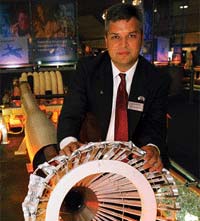ALAN DRON
A small Californian company with just 65 employees has become a vital piece in the jigsaw that enabled Smiths Aerospace to get on board the Boeing bid to supply the US Air Force with Boeing 767 tankers.
Smiths bought Able, of Yorba Linda, near Los Angeles, for its hose unit technology. This blended in with other Smiths' businesses such as its Grand Rapids, Michigan-based Electronic Systems (hose reel controller and programme management) and Aero- structures Hamble (wing pod structures and pressure box for the centreline refuelling station).

Ability
"We believe we were chosen because we had all the capabilities," says John Armendarez, director, military air programmes – military air transport, at Smiths Aerospace Electronic Systems. Also, he adds: "The emphasis is on our ability to integrate bits of equipment together, even if they are not our bits. Boeing sees the value in that."
Smiths has now entered full-scale development for the integrated aerial refuelling and mission control system for the 767.
Among the innovations that Able brought to Smiths' bid for the Boeing 767 tanker programme – the US aerospace giant is in negotiations with the US Air Force to lease 100 of the aircraft – was a microprocessor controller that replaced the traditional mechanical system controlling hose reel deployment and retraction. This improves response speed by about 10%.
Armendarez says Boeing is looking at several refuelling variants of the 767: "The US Air Force will have a drogue and boom on the centreline and hoses on the wings, but some aircraft will just have hose and drogues."
Smiths is also seeking to get on board TTSC, one of the contenders bidding for the Royal Air Force's future strategic tanker aircraft programme, which is intended to provide 20-25 replacements for the service's ageing VC10 and Lockheed L1011 TriStar fleets.
"I would expect a decision within the next couple of months," says Armendarez.
Source: Flight Daily News























